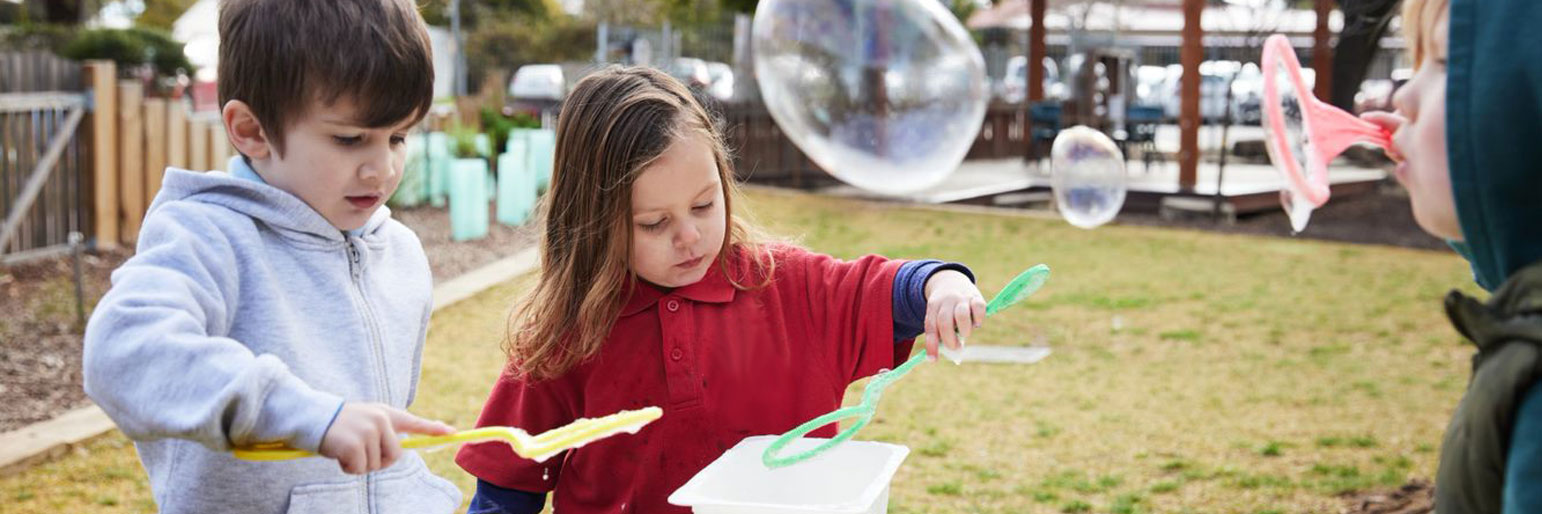Blowing bubbles
Laughing together
Blowing bubbles can be a fun activity to do on a very windy day.

Activity
Bubbles provide an opportunity to explore counting, distance, speed, direction and to experiment with the different language that is used to describe measurement.
What you'll need
- Bubble wands/blowers
- Containers to fit the bubble wands
- Bubble mix
- Ice-cream container
- Wire coat hanger
- Florist wire
- Dishwashing liquid and water mix
Words to use
- High/low, up/down, over/under, in/out
- Fast/slow, quickly, speed
- Hard/soft, blow
- Direction
- Wind, calm
- Small, large, big, little
- One, lots, many, some, more, few
- Pop, bubble, mix, container, wand
- Round, circle
Questions to discuss
- How fast do you need to blow?
- How many bubbles did you blow?
- Who blew the most bubbles?
- Which bubble is the biggest?
- Which direction are they going?
- What happened to the bubbles?
Learning through play
Ways to develop numeracy through play
- As the wind catches the bubbles, explore the different ways that you can describe distance.
- You could talk about how far the bubbles travel as a measurement of time or as a description of height.
- As the wind catches the bubble and lifts it higher, make predictions as to how high it will climb. Will it climb over the fence or even over the roof of the house?
- Take a very big breath of air and see how long you can blow through the bubble blower. Can you count the length of time in your head or do you need someone to count out loud for you?
- Hold and point the bubble blower differently and watch to see if the bubbles travel in different directions. Does it make a difference or will the wind still catch the bubble and float it quickly up into the air?
Ways to develop literacy through play
- Use lots of language to describe the bubbles and where they go.
- If there are several children, make a list of children waiting for a turn. Older children can write their own names.
- Practise tricky sounds like ‘p, p, p’ to blow the bubbles.
- Read fiction and non-fiction books about bubbles eg Pop! A Book about Bubbles by Kimberly Brubaker Bradley and Margaret Miller, or Harry the Dirty Dog by Gene Zion and Margaret Bloy Graham.
- Sing Pop Goes the Weasel:
Round and round the cobbler’s bench,
the monkey chased the weasel,
the monkey stopped to pull up his socks,
POP goes the weasel.
Extensions and variations to this activity
- Use wire coat hangers or florist wire to make bubble blowers of different shapes and sizes.
- Try adding vegetable dye to the bubble mix and then blowing the bubbles onto paper to create bubble pictures.
- Set up a soapy sponge tray using sponge offcuts and a small amount of water and dishwashing liquid. See how hard you need to squeeze the sponges to create foam and bubbles.
- Use a stopwatch or timer on your mobile phone to measure how long before the bubbles burst.
- Make measuring sticks and place them around the yard. Blow your bubble and see if you can float your bubble over the top of the stick. Whose bubble flew the highest?
- It's best to blow bubbles outside. Encourage active play by prompting children to chase after their bubble to see how far it floats, or to ‘race’ their bubble and keep walking/running until it pops.
- Wash dolls in baby baths or plastic containers.
- Wash home corner crockery.
- Wash dress ups or dolls clothes and peg on a line.
- Wash bikes in a ‘car wash’.
Supporting parent engagement in play
Play prompts:
Allowing children to help with simple chores at home like wiping tables, washing plastic dishes or handwashing the baby’s bibs encourages independence and confidence and builds relationships. These chores also start to build an understanding of hygiene and cleanliness for children.
Parents or carers can:
- Comment on what their children are doing (say what they see).
- Talk in their home language.
- Use literacy and numeracy words (see words to use section above).
You can help families by:
- Modelling what you want them to do.
- Talking to them about the focus of the activity and what children might be learning.
- Writing up words that go with the activity.
- Making suggestions on what families can do at home.
Related Great Start activities
Great Start activities are for parents and carers to do with their children.


